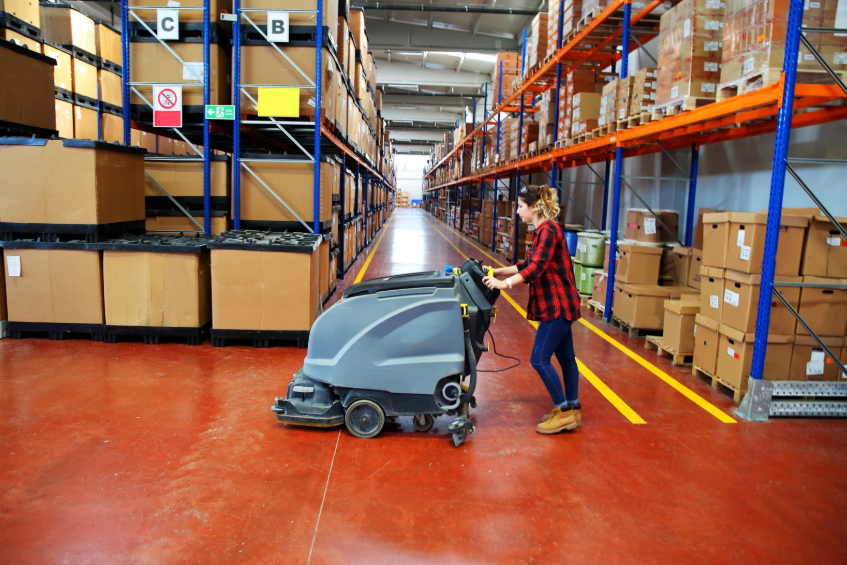Warehouse cleaning is essential for ensuring a safe, efficient, and productive working environment. A well-maintained warehouse reduces risks, improves operational efficiency, and enhances overall workflow. Without proper warehouse cleaning, businesses may face hazards, inventory mismanagement, and decreased employee morale. Implementing structured cleaning and organization practices ensures smooth operations and compliance with safety standards. This article explores the best practices for maintaining a clean and organized warehouse to help businesses improve efficiency and safety.
The Importance of Warehouse Cleaning and Organization
Warehouse cleaning plays a crucial role in maintaining workplace safety and efficiency. A disorganized and dirty warehouse increases the chances of accidents, such as slips, trips, and falls. Clean floors, properly stacked inventory, and well-maintained pathways contribute to a safer environment for employees. Additionally, warehouse cleaning ensures compliance with health and safety regulations, preventing potential fines and legal issues. When cleaning and organization are prioritized, workers can easily locate and retrieve items, reducing downtime and increasing productivity.
Daily Cleaning and Maintenance Checklist
Establishing a daily warehouse cleaning checklist is essential for maintaining order and hygiene. Regular sweeping and mopping of floors prevent dust buildup and reduce the risk of slipping hazards. Waste disposal protocols should be strictly followed to keep aisles clear and prevent pest infestations. Clear and unobstructed pathways ensure that employees and equipment can move efficiently without obstacles. Moreover, disinfecting high-touch surfaces, such as door handles, equipment controls, and break areas, helps maintain hygiene and prevents the spread of illnesses.
Proper Inventory Management for Organization
Effective inventory management is a key component of warehouse cleaning and organization. Implementing a structured labeling and categorization system prevents misplaced items and reduces retrieval time. Utilizing barcoding and RFID tracking minimizes errors and enhances inventory accuracy. The First In, First Out (FIFO) method ensures that older stock is used before newer stock, reducing product spoilage and wastage. Designating specific zones for different product categories further enhances organization, making warehouse cleaning and maintenance more manageable.
Optimizing Warehouse Layout for Efficiency
A well-planned warehouse layout significantly improves efficiency and warehouse cleaning efforts. Strategic shelving and space utilization ensure that storage areas are maximized without causing congestion. Designated areas for receiving, storage, and dispatch streamline operations and prevent workflow bottlenecks. Maintaining clear emergency exits and marked pathways ensures quick and safe evacuation in case of emergencies. Additionally, ergonomic considerations, such as proper shelf height and easy access to frequently used items, contribute to a more organized and functional warehouse.
Implementing Standard Operating Procedures (SOPs)
Establishing Standard Operating Procedures (SOPs) for warehouse cleaning and organization ensures consistency and accountability. Clearly defined guidelines outline cleaning schedules, responsibilities, and expectations for all employees. Assigning specific cleaning and maintenance tasks to staff members promotes accountability and prevents neglect. Regular training sessions educate employees on the importance of warehouse cleaning and how to properly execute cleaning protocols. By adhering to SOPs, businesses can maintain a consistently clean and organized warehouse environment.
The Role of Technology in Warehouse Organization
Technology plays a vital role in modern warehouse cleaning and organization. Warehouse Management Systems (WMS) help track inventory levels, reduce errors, and streamline logistics. Automated cleaning equipment, such as robotic floor scrubbers, enhances efficiency and reduces manual labor. Digital checklists and monitoring tools provide real-time tracking of cleaning tasks, ensuring accountability and thorough execution. Investing in technology-driven solutions simplifies warehouse cleaning while improving overall operational efficiency.
Regular Inspections and Audits
Conducting regular inspections and audits is a proactive approach to warehouse cleaning and organization. Scheduled deep-cleaning sessions remove accumulated dust, debris, and potential safety hazards. Safety inspections identify risks such as damaged shelving, unsecured items, or faulty equipment. Keeping maintenance logs ensures that cleaning tasks are completed on time and that potential issues are promptly addressed. By implementing regular audits, businesses can continuously improve warehouse cleaning standards and maintain a safe working environment.
Encouraging a Clean and Organized Warehouse Culture
Creating a culture of cleanliness and organization encourages employees to take responsibility for warehouse cleaning. Recognizing and rewarding employees who contribute to maintaining cleanliness fosters a sense of pride and accountability. Establishing a workplace cleanliness policy ensures that all employees understand their roles in keeping the warehouse clean. Providing feedback and encouraging suggestions for improvement create a collaborative approach to warehouse cleaning and organization, benefiting the entire workforce.
Takeaway
Warehouse cleaning is an essential practice that directly impacts efficiency, safety, and productivity. By implementing best practices such as daily maintenance, proper inventory management, optimized layouts, and the use of technology, businesses can maintain a clean and organized warehouse. Regular inspections and fostering a culture of cleanliness ensure long-term success and compliance with safety regulations. Prioritizing warehouse cleaning not only enhances operations but also creates a safer and more productive working environment for employees.











